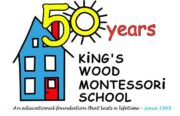The Montessori curriculum seeks to cultivate children’s natural curiosity. To allow them to discover the answers to their “why” questions, King’s Wood Montessori students have been learning about the Human Body!
Students use body models and puzzles, a tiny skeleton to connect the bones inside our bodies, some real bones to look at, and a 3-dimensional torso model with removable organs to learn about the human body.
The Kindergarten class does an in-depth study about the various organs of the human body by using organ system puzzles that separate into circulation, digestion, muscles, bones, and skin. They also create a skeleton by tracing the outline of their body and cutting and labeling the organs.
Students studied their senses in-depth by experimenting with what it’s like to use other senses when one is impaired. For example, children took turns wearing blindfolds and had to rely on feeling their way or being guided by listening to their friends’ voices. They learned how to sign the words love, eat, no, stop, and cat.
The teachers introduce students to books and literature that provide them with even more detail about the working of a human body. They read a story about Temple Grandin, famous for having autism, and her work with animals! The class discussed how people with autism have different “wiring” in their brains than typical people and how this impacts the senses and their perception of the world. Students also took a closer look at their fingerprints to determine if they had whorls, loops, or arches!
Aside from the anecdote it provides, studying bodies is more than just a curriculum. The children’s enthusiasm for making their body pictures is different from what they have for animals and their habitat or weighing or measuring. For one thing, they are all interested; for another, the conversation is specific, animated, and good-natured. Most notable, however, is the sense of relaxed but intense concertation that settles over the room.

